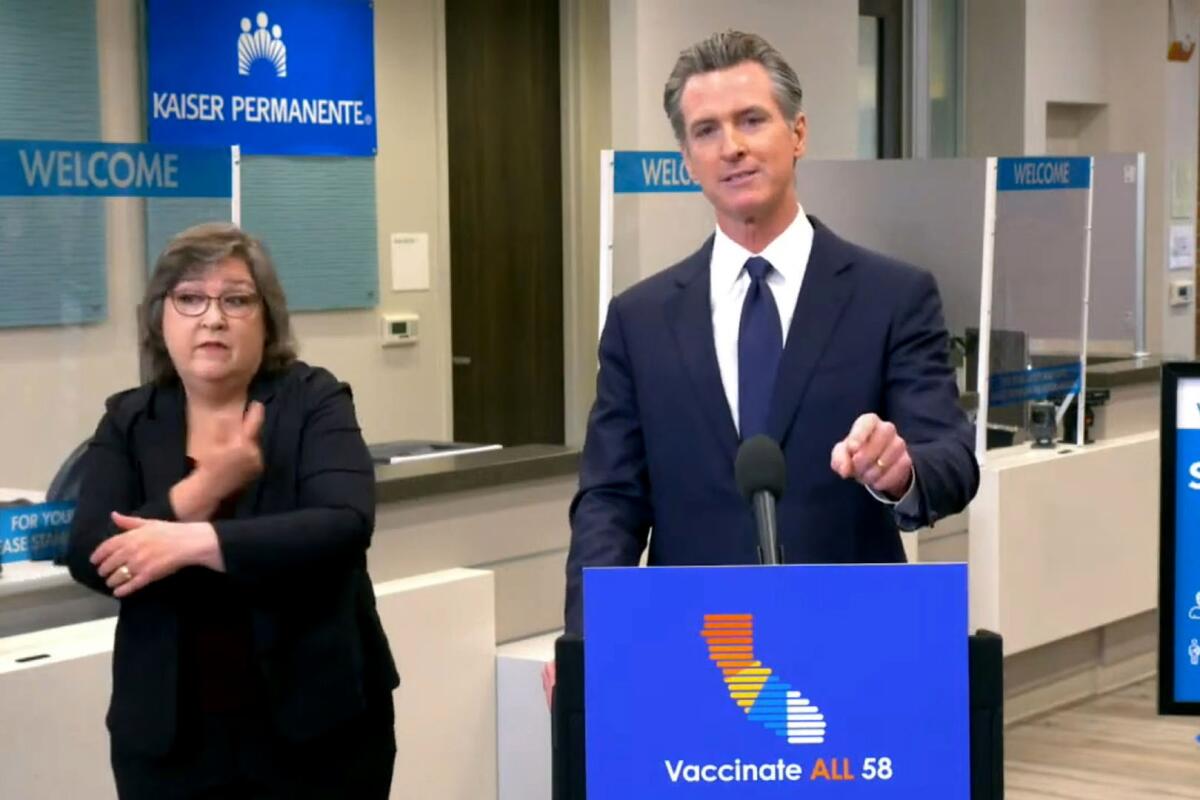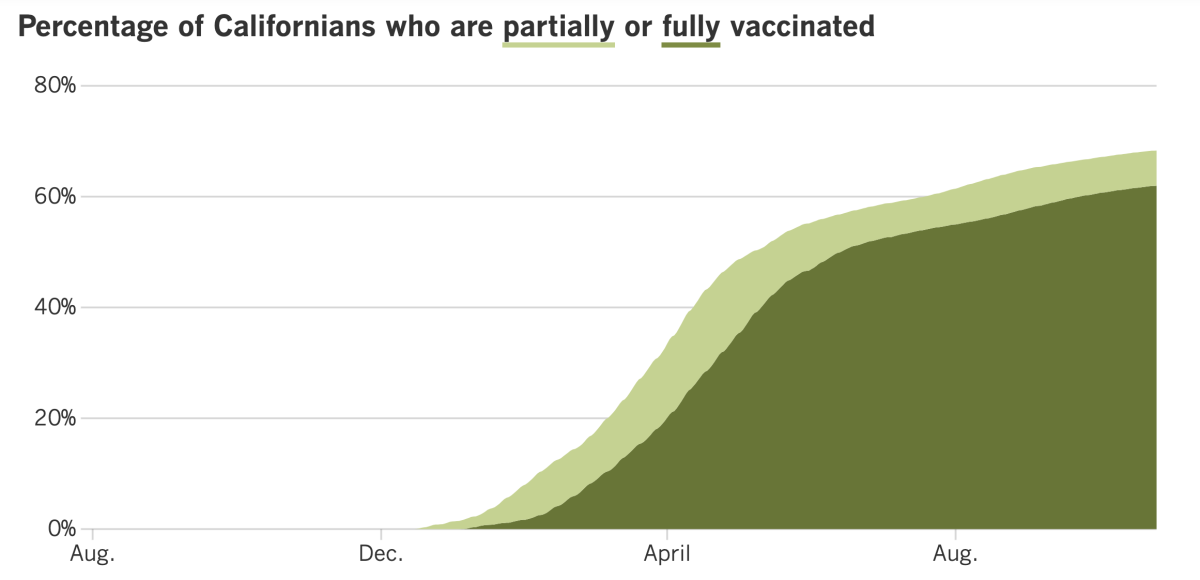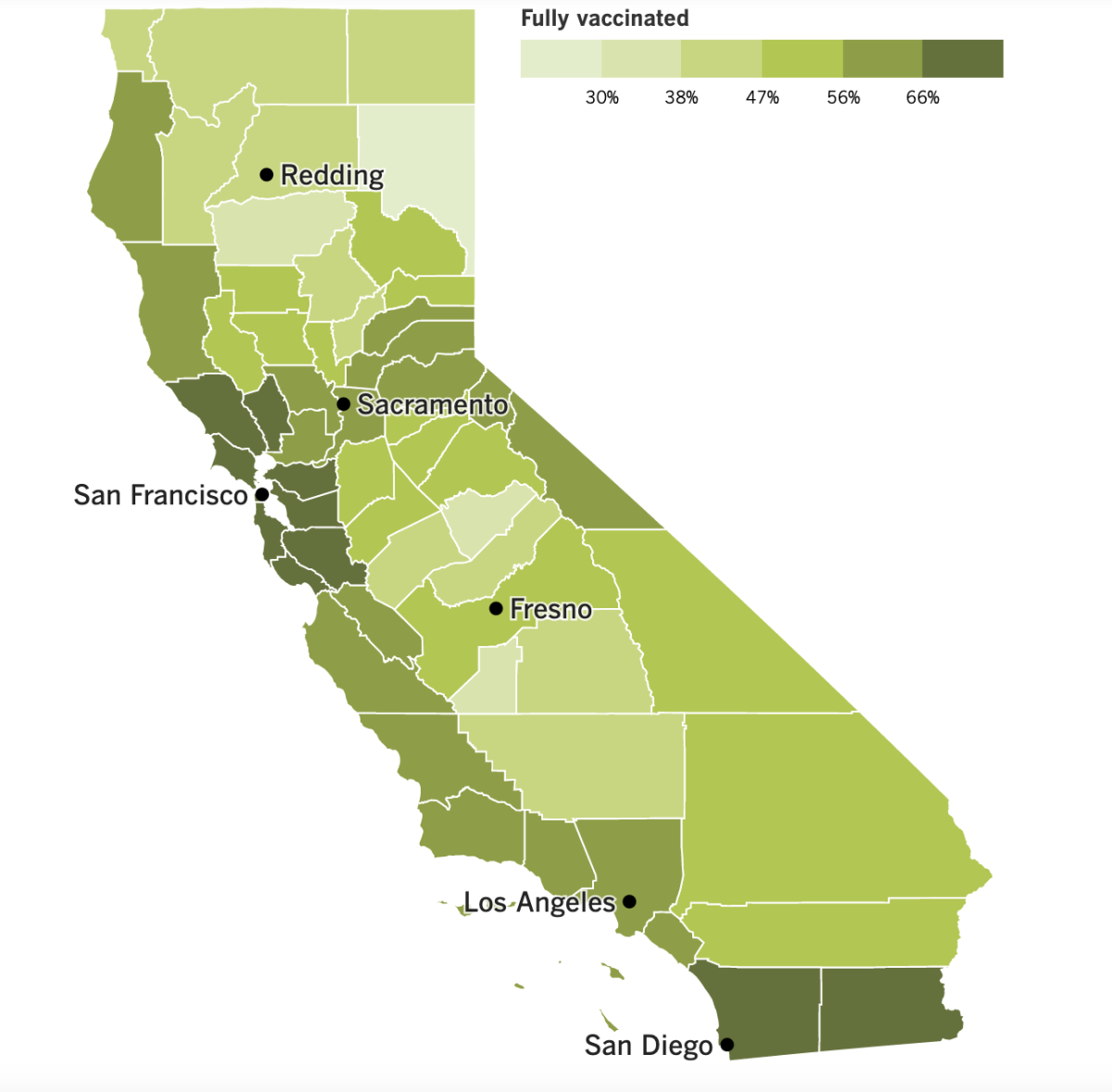Coronavirus Today: California is not exactly leading by example
Good evening. Iâm Karen Kaplan, and itâs Tuesday, Oct. 26. Hereâs the latest on whatâs happening with the coronavirus in California and beyond.
Gov. Gavin Newsom grabbed headlines in July when he became the first governor to require state employees to be vaccinated against COVID-19 or be subjected to weekly coronavirus testing. As head of the largest employer in the state, he pledged to lead by example â and at the time, he sure sounded like he meant it.
âItâs [a] choice to live with this virus. And, with all due respect, you donât have a choice to go out and drink and drive and put everybody elseâs lives at risk,â Newsom said back then. âThatâs the equivalent of this moment with the deadliness and efficiency of the Delta virus. Youâre putting other peopleâs, innocent peopleâs, lives at risk.â
Three months later, many of the stateâs public agencies are reporting low vaccination rates, and thousands of unvaccinated workers are not being tested regularly, my colleague Melody Gutierrez reports.
âThis is problematic,â said Dr. Monica Gandhi, an infectious-disease expert and professor of medicine at UC San Francisco. âThe entire point of Gov. Newsom being the first governor to say state employees should be vaccinated is because these employees are public interfacing, and the vaccine protects them and the public they serve. Then, if the testing component isnât being universally applied, you are defeating the point.â
As of Monday, 74% of California adults were fully vaccinated against COVID-19. By comparison, only 66% of state employees have turned in documentation to show they are fully vaccinated, according to data from the state Department of Human Resources.
At the Department of Motor Vehicles, just 59% of workers have shown theyâre fully vaccinated. At the California Highway Patrol, only about half of employees have submitted proof of vaccination, and at the Department of Forestry and Fire Protection, fewer than a third have done so.
Some departments havenât reported any vaccination data at all, even though the deadline for being vaccinated or submitting to weekly testing was Aug. 2.

Speaking of that testing requirement, roughly 59,000 unvaccinated state employees should be subject to it. But only about half of them were tested as required during the first week of October, according to the stateâs human resources department.
The DMV is testing just 411 of its 3,600 unvaccinated employees each week. And that looks good compared with Cal Fire, which is testing 75 of 6,700 unvaccinated workers.
It gets worse: Out of 152 state departments, 104 havenât set up testing at any of their locations.
Luckily, few of the tests that are being conducted are coming back positive. During the week of Oct. 4, 31,535 tests were administered, and 155 were positive â a positivity rate of less than 0.5%.
The state rule does not apply to employees who work remotely on a full-time basis. Because of that loophole, the true number of fully vaccinated workers may be higher than is reflected in the official records.
For instance, 62% of workers at the stateâs Human Resources department have submitted proof of full vaccination. But Eraina Ortega, the departmentâs director, suspects there are others who are vaccinated but havenât gotten around to documenting it because theyâre telecommuting full-time. As long as theyâre working at home, thereâs no urgency for them to do it.
Erin Mellon, a spokeswoman for Newsom, said Californiaâs testing program was still ramping up: âIt has been a monumental effort to organize regular, free testing across the state workforce of more than 200,000 people.â
By the numbers
California cases and deaths as of 5:40 p.m. Tuesday:

Track Californiaâs coronavirus spread and vaccination efforts â including the latest numbers and how they break down â with our graphics.
Justice for fans of masks
Have you ever found yourself sharing air with someone who is not wearing a mask, even though theyâre in a public place where face coverings are required? Perhaps you got up the gumption to politely ask them to mask up â and perhaps that left you trapped for 11 hours on an airplane next to a sneering passenger who pointedly kept his mask hanging uselessly below his nose.
If youâve ever found yourself wishing the Mask Police could magically appear and put a public-health scofflaw in his or her place, my colleague Hannah Fry has a story for you.
The heroes of this story are the members of an Orange County jury who returned a guilty verdict in the case of People of the State of California vs. Marianne Campbell Smith. It took them roughly an hour to determine that Smith had broken the law by refusing to don a face mask inside a Costa Mesa supermarket.
Smith had been attending an anti-mask rally outside Motherâs Market in August 2020 when she decided to go in to buy a salad and some chips. Store employees and a security guard followed her and asked her to put on a mask or leave the market.
Smith responded by saying she couldnât wear a mask because of a medical condition, according to her attorney. (This despite the fact that she was carrying a sign that read: âHealthy people do not wear masks.â)
Store employees could work with that. They offered to do her shopping for her while she waited outside, the prosecutor explained to the jury. But Smith insisted on doing it herself, rebuffing multiple requests to leave.

When she approached a cashier to pay for her items, market employees refused to serve her. She left $5 near the register.
But she couldnât leave the store; employees had closed the entrance to keep the approaching protesters out. She waved at them, then badgered an elderly shopper, prosecutors said.
âYou donât have to be scared,â Smith allegedly told the customer. âItâs all a lie.â
Smith was found guilty of misdemeanor trespassing and obstructing a business or its customers. Those charges may seem odd, but prosecutors said the case was really about whether a private business has the right to enforce its policies and whether Smithâs act of mask defiance was meant to interfere with the supermarketâs operations.
âThe defendant wanted to make this about masks and freedom,â Dist. Atty. Todd Spitzer said in a statement that was read in court. âThis trial was about a private business and workers just trying to comply with health orders.â
Smith wasnât buying it.
âIâm innocent,â she said as she left the courthouse. âEven though the verdict was guilty, I committed no crimes except to be able to breathe oxygen.â
The judge sentenced her to 40 hours of community service, a $200 fine and a year of informal probation. She was also ordered to stay away from Motherâs Market for a year.
Californiaâs vaccination progress


See the latest on Californiaâs vaccination progress with our tracker.
Your support helps us deliver the news that matters most.
In other news ...
The Los Angeles City Council voted Tuesday to give police officers, firefighters and other city workers more time to get their COVID-19 shots or seek a medical or religious exemption. (Sorry, Steve Lopez.)
Workers now have until Dec. 18 to meet the deadline. If they miss it, theyâll face âcorrective action.â Notices that begin the termination process could be handed out to defiant workers once that deadline is missed.
During the grace period, workers who remain unvaccinated must get coronavirus tests twice a week â and theyâll have to foot the bill. The plan calls for $65 to be deducted from their paychecks for each test theyâre required to take, though that will be reimbursed if and when an employee is granted a medical or religious exemption.
Students in L.A. Unified high schools who participate in sports, band or drill team have until Oct. 31 to show that theyâre fully vaccinated â and thousands have not yet done so.
The school district acknowledged that 30% of students involved in athletics or music programs had not submitted proof of vaccination as of Monday. LAUSD shared that figure after a Times review of vaccination records showed that 40% of students were at risk of being cut from activities.
The vaccine requirement initially applied to students involved in all extracurricular activities, but on Monday, the district said it had scaled back the requirement to focus on sports.
Millions of younger children moved a step closer to getting vaccinated Tuesday after a group of experts that advises the Food and Drug Administration on vaccines voted in favor of making Pfizer and BioNTechâs shots available to children ages 5 to 11.
The shots come in a dose thatâs a third of the size of the ones used in adults and adolescents. Though smaller, it was enough to prompt youngsters to develop an antibody response equivalent to that seen in teens and adults who got full-strength shots. In a clinical trial, the vaccine â given in two injections three weeks apart â reduced the risk of COVID-19 by 91%.
The clinical trial was too small to tell whether the vaccine would cause some recipients to develop a heart-related side effect that had been seen in teens and adults under 30, especially boys and young men. Despite the uncertainty, the FDA advisors decided the vaccine should be available to parents so they can decide whether to immunize their children.
The agency doesnât have to follow the panelâs advice. If it does, the Centers for Disease Control and Prevention will decide whether to recommend the shots for this age group, and under what circumstances. A CDC advisory panel is scheduled to discuss the issue next week.
Meanwhile, Moderna said Monday that a low dose of its vaccine was safe and effective in kids ages 6 to 11.
The vaccine was tested in a trial involving nearly 5,000 children. Among those who got the vaccine instead of a placebo, antibody levels were similar to those seen in adults who received the full-strength dose.
As with adults, the two-shot vaccine caused temporary side effects like fatigue, headache and fever. Like the Pfizer trial, the Moderna one was too small to detect rare side effects, such as heart inflammation.
In other Moderna news, the company announced Tuesday that it would make up to 110 million doses of COVID-19 vaccine available to countries in Africa, with the first 15 million doses arriving before yearâs end. The vaccine will be available for purchase at the companyâs âlowest-tiered price,â Moderna said.
To make the sale possible, the United States said it would defer delivery of about 33 million doses of the Moderna vaccine that had been expected this winter.
âIt is a great day for us,â said Strive Masiyiwa, the African Union special envoy on COVID-19. African nations have faced months of frustration over richer countriesâ hoarding of vaccines and the delayed delivery of doses.
If all goes according to plan, 450 million Africans can be vaccinated by September 2022. The long-term goal is to vaccinate 900 million people, 70% of the continentâs population.
And finally, scientists in San Diego have received a $2.6-million grant from the National Institutes of Health to aid them in their quest to create a universal coronavirus vaccine. This shot would not only protect against an array of coronavirus variants that cause COVID-19 but would also work against other coronaviruses that cause diseases like SARS, MERS and even common colds.
The research team at the La Jolla Institute for Immunology is collaborating with scientists in Boston to develop this dream vaccine. In order to work, it will have to target parts of the virusâ surface that are shared by all coronaviruses. Once any such regions are identified, the La Jolla team will design the vaccine itself.
âWeâre trying to ward off the next pandemic,â said Erica Ollmann Saphire, president of the research institute.
Your questions answered
Todayâs question comes from readers who want to know: Should I use a different type of COVID-19 vaccine for my booster shot?
Depending on your situation, the answer might be yes.
There are certain groups of people who should think about avoiding specific vaccines, experts say.
Younger women who are inclined to get a booster dose of the Johnson & Johnson vaccine might want to talk to their doctors first about the fact that safety monitors have detected several dozen cases of a rare blood clotting disorder in people who got that shot.
The 47 cases flagged through mid-October represent a tiny fraction of the 15.3 million doses delivered, but the disorder â thrombosis with thrombocytopenia syndrome, or TTS â is serious. It causes clots that are difficult to treat and has resulted in five deaths.
More than three-quarters of the people who developed TTS after getting the J&J shot were women ages 18 to 49, and four or the five who died were women. Thatâs enough for women under 50 to consider a booster dose of the Pfizer-BioNTech or Moderna vaccine instead.
Another group with something to think about is men under 30. Thatâs due to the increased risk of heart inflammation following a Pfizer or Moderna shot.
Safety monitors say there have been 37 to 39 cases of myocarditis or pericarditis per 1 million men ages 18 to 24 who got a second dose of either of the mRNA vaccines. The risk was highest for men under 21, but it persisted through age 29.
Since the conditions were more common after the second dose than the first, some experts fear they could see even more cases after a third dose. That might be a reason to opt for the J&J booster instead.
Finally, if you have a personal or family history of Guillain-BarrĂŠ syndrome, or GBS, you may want to steer clear of the Johnson & Johnson vaccine.
GBS is a reaction to an infection or vaccine that causes the immune system to attack the nerves. It can result in paralysis that lasts for months.
At least 130 reports of GBS in people who got the J&J shot â but not the mRNA vaccines â have come in to safety monitors in the U.S. Regulators in Britain have seen cases of GBS following vaccination with AstraZenecaâs COVID-19 shot, which has a design similar to J&Jâs.
If you think any of these scenarios apply to you, consider a consultation with your doctor before making up your mind.
We want to hear from you. Email us your coronavirus questions, and weâll do our best to answer them. Wondering if your questionâs already been answered? Check out our archive here.
Resources
Need a vaccine? Keep in mind that supplies are limited, and getting one can be a challenge. Sign up for email updates, check your eligibility and, if youâre eligible, make an appointment where you live: City of Los Angeles | Los Angeles County | Kern County | Orange County | Riverside County | San Bernardino County | San Diego County | San Luis Obispo County | Santa Barbara County | Ventura County
Practice social distancing using these tips, and wear a mask or two.
Watch for symptoms such as fever, cough, shortness of breath, chills, shaking with chills, muscle pain, headache, sore throat and loss of taste or smell. Hereâs what to look for and when.
Need to get tested? Hereâs where you can in L.A. County and around California.
Americans are hurting in many ways. We have advice for helping kids cope, resources for people experiencing domestic abuse and a newsletter to help you make ends meet.
Weâve answered hundreds of readersâ questions. Explore them in our archive here.
For our most up-to-date coverage, visit our homepage and our Health section, get our breaking news alerts, and follow us on Twitter and Instagram.




